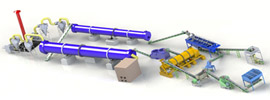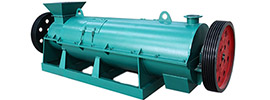Coconut coir, a byproduct of coconut shell fiber processing, is characterized by its loose texture, strong water retention, near-neutral pH, and rich cellulose content. When scientifically processed, it can be transformed into high-quality organic fertilizer. Below is a detailed step-by-step guide and key considerations for producing organic fertilizer from coconut coir:
I. Raw Material Preparation and Pretreatment
- Collection of Coconut Coir
- Sources: Coconut processing factories, coconut fiber product manufacturers, or commercially available compressed coconut coir bricks.
- Impurity Removal: Manually screen or sieve to eliminate non-organic contaminants like sand, stones, and plastic fragments.
- Crushing Treatment
- Use a crusher to break down coconut coir into fine particles (recommended size ≤2 cm) to increase surface area for microbial decomposition.
- If using compressed coconut coir bricks, soak them in water (5–10 liters per brick) to soften before crushing.
- Adjusting Carbon-to-Nitrogen Ratio (C/N)
- Coconut coir has a high carbon content (C/N ≈ 100:1), necessitating the addition of nitrogen sources (e.g., chicken manure, cow dung, soybean meal, urea) to balance the ratio.
- Recommended Ratio: Coconut coir:nitrogen source = 3:1 (by volume), e.g., 3 parts coconut coir + 1 part chicken manure.
II. Composting Process
Method 1: Windrow Composting (Suitable for Large-Scale Production)
- Mixing Raw Materials
- Thoroughly blend crushed coconut coir with nitrogen sources and microbial inoculants (e.g., EM bacteria, Bacillus subtilis). Adjust moisture to 50%–60% (hand-squeezed mixture should form a ball without dripping water).
- Pile Construction
- Form windrows with a height of 1–1.5 m, width of 1.5–2 m, and unlimited length.
- Cover with plastic film or waterproof tarps to minimize moisture loss and odor dispersion.
- Pile Management
- Temperature Monitoring: When the pile temperature reaches 55–65°C, maintain for 3–5 days to kill pathogens and weed seeds.
- Turning Frequency: Turn the pile every 5–7 days to aerate and mix uniformly. Repeat 3–4 times.
- Composting Duration: Approximately 30–45 days in summer; over 60 days in winter.
Method 2: Container Composting (Suitable for Households/Small-Scale Use)
- Filling Containers
- Transfer the mixed raw materials into plastic buckets or fermentation tanks, filling to 80% capacity.
- Sealed Fermentation
- Securely close the lid but leave a vent (e.g., a hose connected to the outside) to prevent gas buildup.
- Store in a shaded, ventilated area away from direct sunlight.
- Regular Venting
- Open the lid every 3–5 days to stir the mixture, release gases, and check moisture levels.
III. Maturity Assessment and Post-Processing
- Maturity Indicators
- Appearance: Color changes from light yellow to dark brown or black; texture becomes loose and crumbly.
- Odor: No pungent ammonia smell; emits a faint earthy aroma.
- Temperature: Pile temperature drops to ambient levels.
- pH: Nears neutral (6.5–7.5).
- Post-Processing Steps
- Screening: Use a 2–3 mm sieve to remove undecomposed large particles.
- Drying: Spread the compost to air-dry until moisture content ≤30% for storage.
- Further Crushing (Optional): Pulverize into fine powder to enhance application efficiency.
IV. Application Methods
- Base Fertilizer
- Prior to sowing or transplanting, apply 1–2 kg of matured coconut coir compost per square meter and mix thoroughly with soil.
- Top Dressing
- During the growing season, apply 50–100 g per plant monthly. Dig trenches around the root zone and bury the fertilizer.
- Blending Recommendations
- Mix with garden soil at a 1:1 ratio to improve soil structure.
- Combine with other organic fertilizers (e.g., vermicompost, general compost) to boost nutrient content.
V. Key Considerations
- Avoid Uncomposted Use: Uncomposted coconut coir is rich in cellulose, which may cause nitrogen immobilization, leading to plant chlorosis.
- Salt Management: Some coconut coir has high salt content. Rinse with water acidified with citric acid (10 g per liter) until electrical conductivity (EC) ≤1.0 mS/cm.
- pH Adjustment: If pH <5.5, add limestone powder (1–2 kg per cubic meter) to neutralize acidity.
- Storage Conditions: Seal and store matured compost in a dry place to prevent caking or pest infestation.
VI. Advantages and Limitations
- Advantages:
- Eco-friendly utilization of agricultural waste, reducing pollution from coconut shell burning.
- Improves soil aeration, ideal for clayey soil amendment.
- High water retention reduces irrigation frequency.
- Limitations:
- Low nutrient density alone; requires supplementation with NPK fertilizers.
- Initial processing demands time and equipment investment.
This guide provides a practical framework for transforming coconut coir into nutrient-rich organic fertilizer, promoting sustainable agriculture while minimizing waste.
 Send us a Email
Send us a Email Wulong Industrial Cluster
Wulong Industrial Cluster Have any question?
Have any question?



















